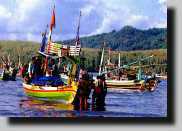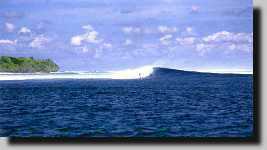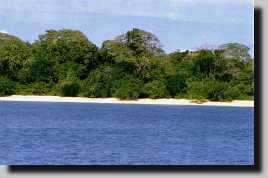
Travel Notes
 After this unplanned
diversion we set off again towards Sadengan. At Kalipahit the
road forked to the left. From here it was just a short 15 km
to the edge of the preserve and the beginning of Alas Purwo (first,
or original forest), another name given to the Blambangan Peninsula.In
former times the region was covered in mixed monsoon forest,
but recently extensive teak plantations have begun to encroach
on the landward side. A comparatively dry climate has made the
area an ideal location for production of the wood. After this unplanned
diversion we set off again towards Sadengan. At Kalipahit the
road forked to the left. From here it was just a short 15 km
to the edge of the preserve and the beginning of Alas Purwo (first,
or original forest), another name given to the Blambangan Peninsula.In
former times the region was covered in mixed monsoon forest,
but recently extensive teak plantations have begun to encroach
on the landward side. A comparatively dry climate has made the
area an ideal location for production of the wood.
The road eventually deteriorated into a rough track and we were
twisting and turning through the forest, arriving finally at
the edge of a large expanse of open savannah. Climbing a strategically
placed observation tower, we had a perfect view of the area,
which is a popular feeding ground for the animals in the mornings
and late afternoons. Aside from a large number of banteng, we
saw deer and a few peacocks. Our guide told us that the appearance
of peacocks indicated that there were no tigers in the vicinity.
The banteng kept their distance and at first it seemed that photographing
was going to be a problem. However, the guide suggested that
one of us venture out into the open with him and attempt to approach
the animals. Climbing over the boundary fence, we cautiously
and some what nervously headed towards a large bull, which appeared
to be grazing peacefully. The guide, who was obviously used to
this procedure, approached confidently with arms held high to
resemble horns, a not entirely convincing disguise. Carrying
three cameras, the photographer kept low, some distance behind.
At about 40 metres the bull suddenly lifted its head and looked
straight at us, as if to indicate that we had gone far enough.
We didn't argue. Then, after a pause, it turned around and trotted
off to join the rest of the herd grazing in the sun.
Beach
and surf at Plengkung
 |
 |
|

